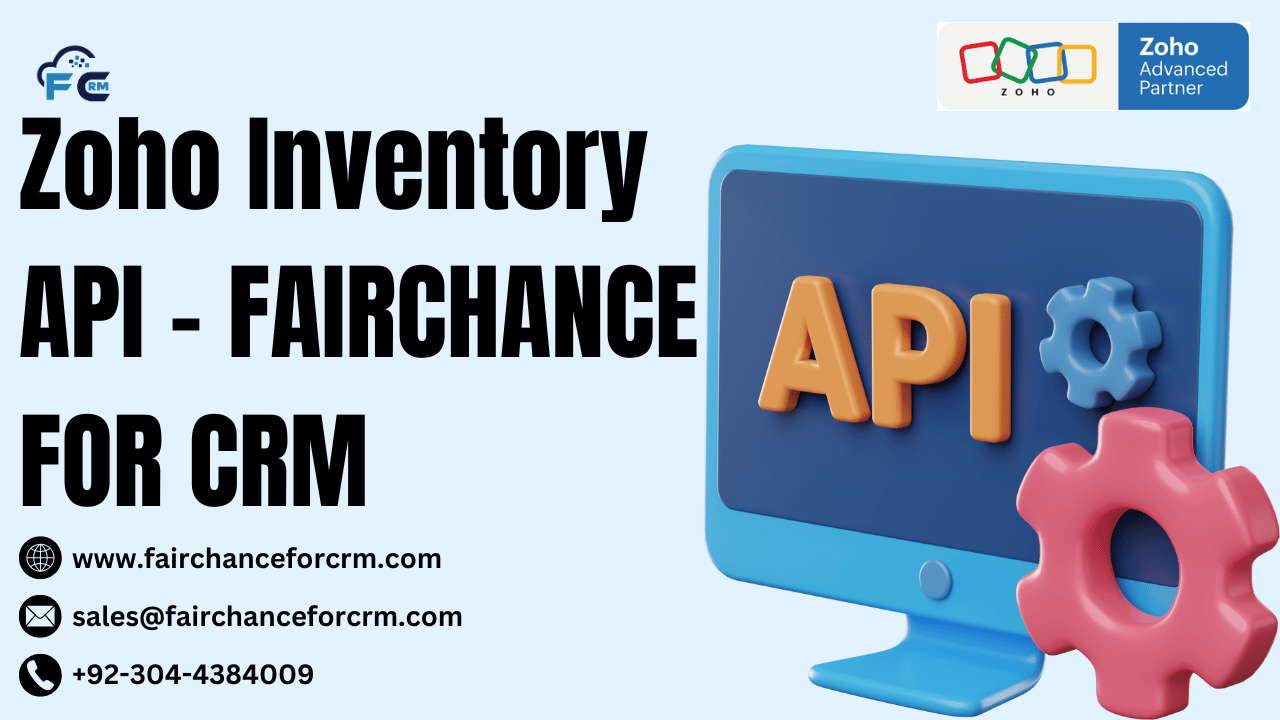For businesses of all sizes, efficient inventory management is crucial, especially for those handling large volumes of orders, goods, and customer data. Zoho Inventory, a part of Zoho’s suite of cloud-based applications, provides tools for inventory tracking, order fulfillment, and sales management across several channels. The Zoho Inventory API extends this functionality by enabling developers to connect Zoho Inventory to other systems and modify workflows to meet specific business needs. The Zoho Inventory API will be discussed in this post along with its features, usage guidelines, and advantages for companies trying to optimize inventory control.
Also Read:
- Zoho Recruit Legit – FAIRCHANCE FOR CRM
- Is Zoho Assist Safe? FAIRCHANCE FOR CRM
- Zoho Valuation: Understanding the Success of Software Giant
- Zoho Shifts: Streamlining Workforce Scheduling for Your Business
- How Zoho Toco Enhances Your Business Workflow – FAIRCHANCE FOR CRM
What Is the Zoho Inventory API?
Programmers can utilize Zoho Inventory’s functionalities using a set of RESTful APIs called the Zoho Inventory API. Developers can include inventory management features straight into their own systems, including CRMs, ERPs, and e-commerce platforms, by using the API.
By providing endpoints for a range of services, including product management, sales orders, purchase orders, shipping, and inventory adjustments, the API allows developers flexibility in managing a range of inventory procedures.
Key Features of the Zoho Inventory API
The Zoho Inventory API offers a broad range of features to help streamline inventory and order management:
1. Product and Inventory Management
- Manage products, create new items, update product details, and delete items as needed.
- Track inventory levels and set up notifications for stock updates, so businesses can avoid stockouts or overstocking.
2. Order and Invoice Processing
- The API allows for seamless order creation, updating, and tracking. In order to automatically handle online orders, it also facilitates interface with e-commerce systems.
- The API allows developers to monitor the status of order fulfillment and automate the creation of invoices.
3. Warehouse and Multi-Location Support
- Businesses with multiple warehouses or storage locations can use the API to track inventory across all locations.
- By enabling stock transfers between warehouses, the API improves visibility and control over inventory management across many locations.
4. Purchase Order and Vendor Management
- Create and update purchase orders, track vendor details, and manage supplier relationships through the API.
- Automating purchase orders helps streamline the restocking process and ensures the business maintains optimal inventory levels.
5. Shipping and Delivery Management
- With endpoints for shipment creation, tracking, and delivery status updates, Zoho Inventory API integrates directly with shipping partners.
- Shipping automation reduces manual data entry, provides customers with accurate tracking, and improves fulfillment efficiency.
6. Advanced Reporting and Analytics
- The API provides access to reports and inventory data, including sales analytics, stock history, and order reports, which can be used to create custom dashboards.
- Integrating data with BI tools enables businesses to get valuable insights into their inventory trends and optimize their supply chain.
How to Use Zoho Inventory API
Using the Zoho Inventory API involves a few key steps, including API access setup, authentication, and endpoint requests. Here’s a step-by-step overview:
1. Access Zoho Inventory API and Obtain API Credentials
- First, users must have a Zoho account with Zoho Inventory enabled. Within the Zoho Inventory settings, they can obtain an API key, which is necessary to access the API.
- Zoho API uses OAuth 2.0 for authentication. Users need to create a client application in the Zoho API Console to get a client ID and client secret, required for generating access tokens.
2. Authenticate Using OAuth 2.0
- The Zoho Inventory API requires OAuth 2.0 authorization. Once the client ID and client secret are obtained, developers need to request an access token. Zoho provides both short-lived and refresh tokens for continuous integration.
- Using the access token, developers can make secure requests to Zoho Inventory’s API endpoints, keeping the application secure and compliant.
3. Make API Requests to Zoho Inventory Endpoints
- Zoho Inventory’s API documentation provides detailed information on all available endpoints, methods, and parameters. This allows developers to interact with products, orders, invoices, warehouses, and more.
- Example endpoints include:
- Items Endpoint:
/api/v1/itemsto create, update, or delete product items. - Sales Orders Endpoint:
/api/v1/salesordersto manage customer orders. - Purchase Orders Endpoint:
/api/v1/purchaseordersto handle supplier orders and restocking.
- Items Endpoint:
4. Process and Store API Data
- Data returned from Zoho Inventory API requests are typically in JSON format. Developers can parse this data and integrate it into other systems, databases, or applications.
- Data parsing enables businesses to synchronize information across their e-commerce platforms, CRM systems, and accounting software for a unified view of inventory and orders.
5. Monitor API Usage and Handle Errors
- Zoho Inventory has API usage limits, so monitoring API calls is essential for avoiding rate-limit issues. The API documentation includes status codes to help developers troubleshoot common errors and improve integration stability.
Benefits of Using Zoho Inventory API
1. Streamlined Inventory Management Across Platforms
-
- Businesses can centralize inventory data and sync it across platforms like accounting software, CRM systems, and e-commerce websites with the help of the Zoho Inventory API.
Errors are decreased, human entry time is reduced, and inventory visibility is enhanced by this optimized data flow.
2. Enhanced Automation for Efficiency
-
-
- With Zoho Inventory API, repetitive tasks such as order creation, inventory updates, and stock level checks can be automated.
Automation expedites order processing, minimizes errors, and reduces manual labor.
-
Businesses can improve operational efficiency by customizing automation to meet their specific demands.
3. Real-Time Updates and Better Stock Control
- Real-time data synchronization ensures that inventory levels are accurate across all systems. When stock levels change in Zoho Inventory, they are updated automatically across integrated platforms.
- Businesses can maximize ordering and prevent expensive stockouts or surplus inventory by improving stock control.
4. Improved Customer Experience
-
- Improved client satisfaction results from the quick and precise order fulfillment made possible by the API integration.
For instance, clients receive real-time updates when shipping and tracking information are integrated, improving their overall business experience.
5. Scalable Solution for Growing Businesses
- Zoho Inventory API is highly scalable, making it ideal for businesses experiencing growth. As companies expand their sales channels or add new warehouses, Zoho Inventory can seamlessly handle these additional needs through API integrations.
- Scalability also makes Zoho Inventory API a cost-effective solution, as businesses only need to integrate and pay for the features they require.
Use Cases for Zoho Inventory API
The flexibility of the Zoho Inventory API makes it suitable for a range of business scenarios:
- E-commerce Integration: Syncing Zoho Inventory with platforms like Shopify, WooCommerce, or Magento for real-time order and inventory management.
- ERP Integration: Connecting Zoho Inventory with ERP systems for centralized inventory control across multiple locations.
- Multi-Channel Sales: Managing inventory across multiple sales channels such as Amazon, eBay, and physical stores by synchronizing all data with Zoho Inventory.
- Automated Reordering: Setting up automatic reorder points based on real-time stock data to keep inventory levels optimal without manual intervention.
- Advanced Analytics: Extracting sales and stock data for integration with business intelligence tools, enabling businesses to make data-driven decisions.
Limitations to Consider
While Zoho Inventory API offers numerous benefits, there are a few limitations to keep in mind:
- API Rate Limits: Zoho imposes usage limits on API calls to prevent server overload. Heavy users or large enterprises might need to adjust workflows or request increased limits.
- Limited Integration with Niche Platforms: While Zoho Inventory integrates well with popular platforms, some specialized systems may not have direct support, requiring additional middleware for integration.
- Learning Curve for API Setup: While the API is well-documented, it may require technical knowledge and time to set up, especially for complex integrations.
Conclusion
Businesses can automate, optimize, and manage inventory and order operations with the help of the Zoho Inventory API. It is the perfect choice for companies looking for a smooth interface with their current systems because it offers versatile capabilities for analytics, order fulfillment, and product administration. The Zoho Inventory API is a useful tool for businesses trying to maximize inventory control and boost operational efficiency because of its strong functionality, security requirements, and scalability, despite a few drawbacks.
FAQs
1. What is the Zoho Inventory API used for?
Businesses may automate processes like order processing, inventory tracking, and shipping updates by integrating Zoho Inventory with other software programs through the Zoho Inventory API.
2. Is Zoho Inventory API secure?
Yes, Zoho Inventory API uses OAuth 2.0 authentication, and data is protected with AES 256-bit encryption, ensuring secure data transfer.
3. Does Zoho Inventory API support multi-location inventory management?
Yes, users can manage and track inventory across various warehouses thanks to the Zoho Inventory API’s multi-location capability.
4. Can I use Zoho Inventory API with my e-commerce store?
Of course. Real-time synchronization of inventory and order data is made possible by the integration of the Zoho Inventory API with well-known e-commerce systems.
5. What are the rate limits for Zoho Inventory API?
Zoho imposes API rate limits to manage server load. The limits depend on the API plan.
For more information about the Zoho Inventory API, visit this link.
If you want to Free Trail Zoho, click on this link.




